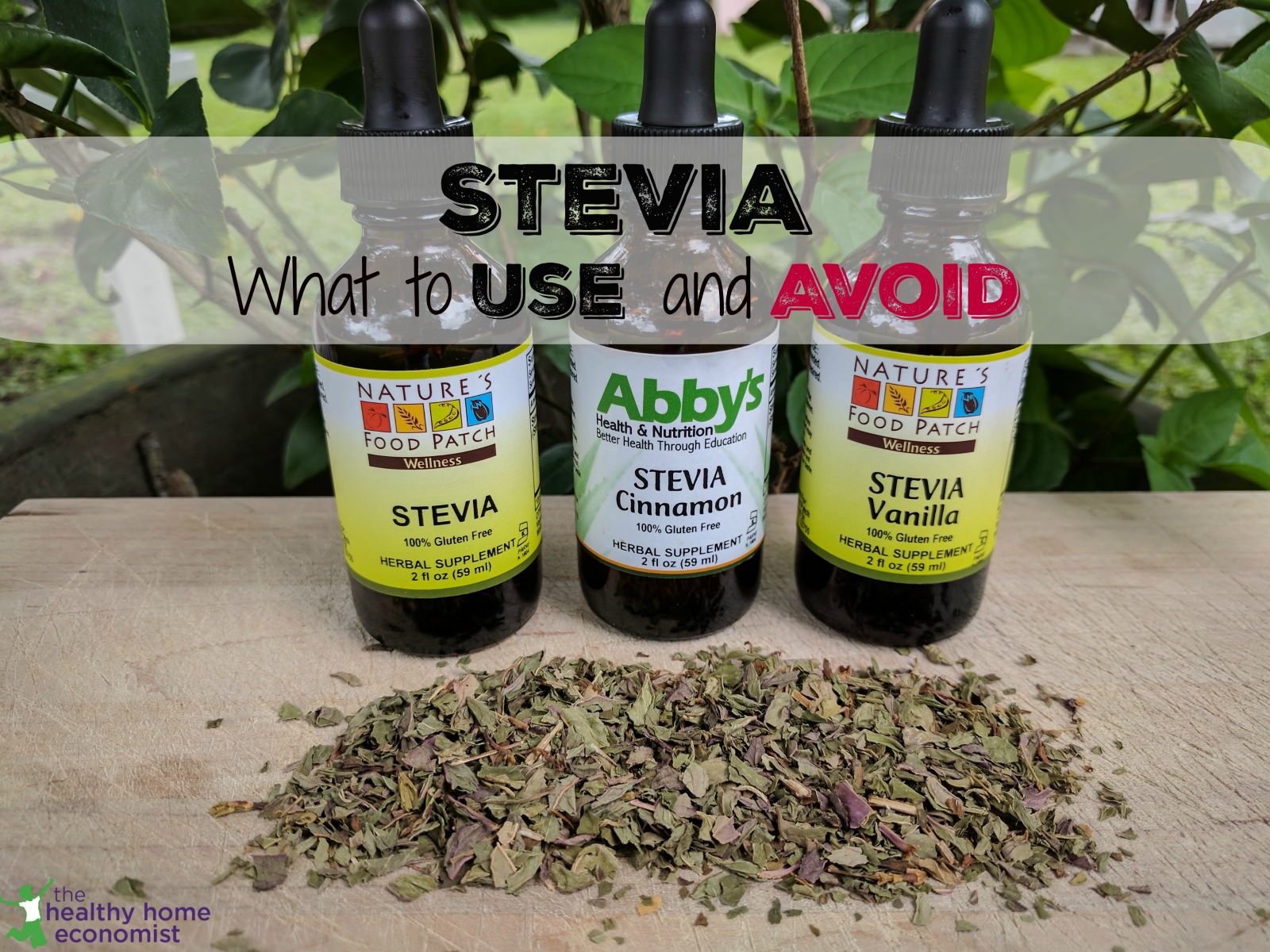Table of Contents[Hide][Show]
- How Much Sugar Does Stevia Replace?
- Types of Stevia
- Stevioside vs Rebaudioside
- Green Leaf Stevia
- Liquid Stevia Extracts
- Processed, GMO Stevia
- Solely Stevia?
- Stevia Processing
- Organic Stevia: Not Necessarily Better
- Stevia and Blood Sugar
- How to Determine Stevia’s Effects on You Personally
- Stevia and Stress Response
- Usage without Stress
- Stevia’s Effect on Hormones
- Stevia and Fertility
- Is Stevia Healthy?
- Quality Sources
 In the increasingly wide and (sometimes) wonderful world of sugar substitutes, what about stevia? Food manufacturers market this naturally sweet herb turned industrialized darling in many forms.
In the increasingly wide and (sometimes) wonderful world of sugar substitutes, what about stevia? Food manufacturers market this naturally sweet herb turned industrialized darling in many forms.
Healthfood store shelves have it on offer as green stevia leaf, white stevia powder, stevia extract, and by far the most popular, liquid stevia available in a dozen or so flavors to suit any palate’s sweet desires.
Sugar. Modern day scourge, yet secretly embraced. Americans have a love/hate affair with all things sweet, simultaneously decrying it yet adding it to almost every possible food. This sugar saturation is causing many to seek alternatives that give them the sweet without the calories. Diabetics seek it to enjoy sweetness without the insulin spike. By far, the most widely accepted as natural and healthy are extracts from the leaves of the stevia plant.
How Much Sugar Does Stevia Replace?
For those seeking to reduce their sugar intake, stevia has a significant advantage other many alternatives. First and most importantly, it is intensely sweet with a glycemic index of zero. Some concentrated stevia products are a whopping 500 times sweeter than sugar!
A mere 2-4 drops of liquid stevia extract replaces a teaspoon of cane sugar. One teaspoon of powdered extract replaces an entire cup of sugar in a dessert recipe!
But what exactly is this South American herb known as Stevia rebaudiana? And do we really want to substitute our various natural sugars with it?
Will the real stevia please stand up?
Types of Stevia
There are a number of different types of stevia on the market as listed above. Unfortunately, some of them appear to have very little to do with the whole version that traditional cultures enjoyed.
Stevioside vs Rebaudioside
The two sweet components isolated from stevia leaf for use as a sweetener are steviol glycoside (stevioside) and rebaudioside. Stevioside has a lingering aftertaste while rebaudioside does not.
Stevioside (steviol glycoside) traditionally makes up the majority of the sweetness and health benefits of this ancestral herb. However, when a stevia product contains a higher proportion of rebaudioside vs stevioside, the bitterness and aftertaste lessen considerably. It may even disappear entirely.
The manufacturing methods used to make stevia extract is what affects the quality, characteristics, concentration and taste. Food manufacturers can filter and purify rebaudioside up to 99%. This is why stevia extract containing primarily rebaudiana is more expensive. The more purified and concentrated, the sweeter and less bitter it is. Some versions are up to 500 times sweeter than sugar!
Green Leaf Stevia
Traditional stevia is green and unprocessed. The leaves are simply dried and ground as shown in the foreground of the picture above. Sometimes the dried leaves are pulverized to a fine powder. The whole herb in this form has been used in Japan and South America for centuries as both sweetener and health remedy.
Because green leaf versions contain both sweet components of stevia (rebaudioside and stevioside), the whole form of stevia is slightly bitter and doesn’t have the intense sweetness of other products that are primarily filtered rebaudioside.
Green stevia powder is only 30-40 times sweeter than sugar. The bitterness creates an aftertaste that some people find disagreeable. The good news is that you get used to it after awhile.
Liquid Stevia Extracts
The less bitter part of the stevia leaf (rebaudioside), which lacks the health benefits linked to stevioside, is generally used to make highly concentrated stevia extracts. The result is a far sweeter stevia than the whole green leaf type. It is also free of the disagreeable aftertaste.
Unfortunately, many of these products contain other fillers and ingredients. More on this below. They come in a wide variety of flavors too with a couple of the most popular shown in the picture above.
If you use a stevia extract, make sure it is from a reputable source that discloses all ingredients. Important information to obtain includes how it was processed and that it contains only stevia as the sweetener! The sweetness level generally runs around 100-200 times sweeter than sugar, but can vary a great deal from brand to brand.
Processed, GMO Stevia
Processed “stevia” products include Truvia, PureVia and others are to be avoided without exception. At up to 400 times the sweetness of sugar, these modern industrial amalgamations are “stevia in name only.”
It seems companies want to cash in on stevia’s “natural” and “traditional” street credentials without actually creating a product that is either. These, like the extracts above, don’t contain the beneficial stevioside part of the herb. On the other hand, they do contain a lot of other stuff the consumer likely does not want to consume like GMOs. Let’s look at that next.
Solely Stevia?
Often, stevia products contain a number of other ingredients such as:
- GMO xylitol, erythritol, and various other types of sugar alcohols. These are known to cause gastrointestinal problems and other health issues in sensitive individuals.
- Glycerine – this sticky substance can coat teeth, inhibiting remineralization and other natural processes.
- Dextrose – anti-caking agent, usually made from GMO corn.
- Natural flavors – this is the kitchen sink of processed food, and contains all sorts of things that don’t meet any consumer’s definition of natural!
Note that the problem isn’t just about additives. Processing methods also matter a great deal. Let’s delve into this a bit further.
Stevia Processing
While humans have consumed the stevia plant for a long time, many modern versions bear little resemblance to the original. Worse, these industrialized products bring with them a host of modern contaminants.
Like what? Like ethanol from GMO corn. Let’s take a look at Purevia.
The pure Reb A [rebaudioside] from the stevia plant that sweetens PureVia starts with stevia leaves, which are first milled and then steeped in water using a brewing method that is similar to brewing tea. The resulting stevia extract is then further purified to separate the Reb A through a proprietary technology using ethanol. (1)
But that isn’t all. Purevia also contains sugar alcohol (such as erythritol and xylitol) and the food industry’s favorite catch-all ingredient – natural flavors. It seems the comically named Purevia is not so pure after all.
Other methods of stevia extraction include methanol, toxic solvents, and a host of other chemicals. (2)
It seems our modern day stevia has wandered a long way from the whole leaf!
Organic Stevia: Not Necessarily Better
Warning. There are some organic stevia products on the market where the first ingredient isn’t even stevia! Assuming that buzzwords on the label like organic, nonGMO and all natural mean healthy is risky. For example, the brand Wholesome Sweeteners has an organic stevia with agave inulin as the first ingredient!
Stevia and Blood Sugar
Stevia’s impact on blood sugar is unclear. Between studies and actual patient surveys, it seems best to conclude that stevia has an uncertain and individually specific impact on blood sugar levels. Some of this is because studies sometimes includes parts of the plant that don’t end up in the final, processed form.
For example, a 2005 study published in the journal Planta Medica found that the effect of stevioside on blood sugar levels was dose dependent with stevioside lowering blood glucose levels and decreasing insulin resistance in rats with diabetes. However, this research is preliminary. What’s more, FDA-approved forms of stevia for use in food don’t contain stevioside. Hence, most of the stevia products you can buy in the baking section in grocery stores won’t have this beneficial effect on your blood sugar levels. (3)
How to Determine Stevia’s Effects on You Personally
A glucose meter is the best approach to determining if stevia (and a lot of other foods!) have a negative impact on your body. They are incredibly affordable nowadays with easy to use models costing about $10. You don’t need to be a diabetic to make great use of these on a day to day basis.
Stevia and Stress Response
Some warn that stevia can have a negative impact on the adrenals and other body systems.
Stevia is “sweet” on the palate, so the body assumes it is receiving sugar and primes itself to do so. Glucose is cleared from the bloodstream and blood sugars drop, but no real sugar/glucose is provided to the body to compensate. When this happens, adrenaline and cortisol surge to mobilize sugar from other sources (liver and muscle glycogen, or protein, or body tissue) to bring blood glucose back up. (4)
If this information is accurate, only low to no carb foods containing stevia present an actual concern. In such a scenario, stimulating the body’s sweet response without actually providing any carbohydrates appears to be imprudent. This is likely why the low carb Bone Broth Diet recommends against any stevia at all.
Usage without Stress
However, using stevia in foods that contain carbs as a way to increase sweetness without sugar or calories does not appear problematic. Similarly, using a stevia sweetened dessert with a meal that supplies carbs should not pose any issues.
Chris Kresser L.Ac notes that this particular point remains a contentious issue. Current research combined with information on traditional use versus modern versions leave many divided on stevia benefits.
Because stevia contains almost no calories, one potential issue with stevia is that the sweet taste without the influx of sugar might confuse our insulin response. While this is an understandable concern, stevia has actually been used traditionally as a treatment for diabetics and may actually improve blood sugar control. (5)
Stevia’s Effect on Hormones
As if all the above isn’t enough to chew on, here is a bit more. Stevia may also be a hormone mimicker as pointed out by Dr. Sarah Ballantyne.
Steviol glycosides are synthesized in the same pathway and end up being structurally very similar to the plant hormones gibberellin and kaurene. This means that steviol glycosides have a hormone structure… There is evidence that steviol glycosides have contraceptive effects in both males and females. In particular, one specific steviol glycoside, called stevioside, has been shown to have potent contraceptive properties in female rats, implying that stevia may have an impact on estrogen, progesterone or both.
While small and occasional consumption of stevia likely has little to no impact on general health, it should not be consumed on a regular basis especially by those with altered hormone balance and dysfunctional immune systems. (6)
Stevia and Fertility
Some sources claim that stevia use negatively impacts fertility. However, the studies supporting this assertion have design flaws or otherwise lack merit. Other studies show no negative consequences for fertility. (7)
This doesn’t mean that stevia cannot negatively impact a particular person’s fertility. However, it does mean that on the whole, this negative health effect seems unlikely.
Again, there is significant debate regarding the positive and negative health impacts of this herbal sweetener. It has a clear and long history of favorable use in many parts of the world as a health remedy for a wide range of conditions. However, a few certain and uncertain drawbacks and dangers exist, especially with processed forms.
So where does this leave us in the final analysis?
Is Stevia Healthy?
Some diets like Trim Healthy Mama advocate stevia and other no carb sugar replacements such as erythritol because of macro-nutrient combining rules (fats, carbs, and protein). Stevia allows sweetness without carbs, an approach that has legitimate health concerns touched on above.
For those who follow traditional dietary principles such as Wise Traditions, Paleo, SCD and others, the unprocessed, low temp dried herb and quality extracts appear to have little to no risk if consumed on occasion and in moderation.
At the same time, there is no reason to avoid the many nutrient dense, traditional sweeteners. These include maple syrup, coconut sugar, sucanat, raw honey, yacon syrup and others.
Stevia, like many other no calorie sweeteners is also a low to no nutrient option similar to monk fruit.
Lucuma is similar, though slightly higher in calories. Our ancestors consumed sweeteners not only as a source of calories, but also for valuable nutrients and minerals. Even the whole leaf form of this herb does not compare to the nutrient density of many other traditional sweeteners.
Quality Sources
If you do need or want to use stevia, make sure you are getting only the true herb.
Trusted sources include Frontier and Sweetleaf among others.
Make sure to patronize brands that process without toxic chemicals and solvents. In addition, it should be free from other additives, processed ingredients, and artificial sweeteners.
Finally, don’t consume stevia in any form as part of a meal or snack that contains few to no carbs. This will avoid an undesirable adrenaline and cortisol stress response from stimulating the sweet induced metabolic process without any carbs to support it.








Thoughts on “organic stevia leaf” when used in a protein powder?
All protein powders are toxic. Using protein powder is the fast track to kidney problems. https://www.thehealthyhomeeconomist.com/ditch-that-protein-powder/
An electrolyte replacement product growing in popularity called LMNT uses stevia as its sweetener. I was skeptical to start using it, as the Weston Price foundation warns against stevia use, but due to dehydration in this pregnancy, I decided to give it a try. Over the course of about 3 weeks, I drank 1 packet every 1-2 days. I experienced such agonizing, irrational anxiety. After the anxiety continued to grow, I realized I needed to analyze what I was eating and realized that it was the stevia. I stopped all LMNT drinks, and withing a few days, my mental/emotional health returned. Especially for pregnant mamas, I would strongly caution against the use of stevia.
The sweetleaf that is linked has natural flavors listed as an ingredient. I thought that was bad?
I use it in my mushroom coffee in the morning and use the Trim Healthy Mama brand – tastes the best. After reading this , it looks like this is not good to do. I primarily use it in my drinks.
Also just finished an article by Eat Beautifil Megan Stevens saying studies showing it causes liver and kidney damage! Ugggh.
Guess I will have to find something else or omit.
Can you help explain what purified stevia leaf extract is? I have been searching for ages for a hydration drink with acceptable ingredients. I found one with the above named ingredient but I can’t find a lot of info on it. Any thoughts?
I check my blood glucose daily and wear a continuous glucose monitor and have not found the statement, “Stevia is “sweet” on the palate, so the body assumes it is receiving sugar and primes itself to do so. Glucose is cleared from the bloodstream and blood sugars drop, but no real sugar/glucose is provided to the body to compensate. When this happens, adrenaline and cortisol surge to mobilize sugar from other sources (liver and muscle glycogen, or protein, or body tissue) to bring blood glucose back up. (4)”
to be true in 12 years of stevia use.
For me, the stevia I use has caused neither a drop, nor a rise in my blood glucose over the years.
I’d assume there is variation between brands, however, as you’ve outlined here. I’ve always used the same brand in both liquid and powder forms.
the SweetLeaf in the link above has a natural flavors in it.
I haven’t found one that doesn’t have it. I would recommend green stevia powder instead of you are sensitive.
As someone with Addison’s disease (autoimmune primary adrenal insufficiency–that is, my adrenal cortices were destroyed by my immune system and I no longer make cortisol, aldosterone, or DHEA on my own), I wanted to make sure to help clear up any confusion regarding adrenal issues. I see that this article links to another article where “adrenal fatigue” is mentioned. “Adrenal fatigue” is not an accepted medical diagnosis. If a person is having problems that seem adrenal-related, I encourage them to have their AM cortisol levels checked and an ACTH Stim test run to make sure that their issues are being caused by an adrenal problem and not something else. Actual adrenal insufficiency IS a medical condition that CANNOT be treated by lifestyle or diet changes and can actually be fatal if not treated properly. Other than that, very interesting article, thank you! 🙂
allright, so no stevia right
Actually, the article outlines when stevia is fine to use! Yay!